
Dead Deal Report: Unpacking 2023’s Broken LOIs
There are numerous factors that can lead to the breakdown of a deal, including financing challenges, discrepancies in EBITDA evaluations,…
As the coronavirus crisis continues to evolve, workplace and consumer behavior has transformed rapidly across almost every industry. “Businesses of all kinds are experiencing two years’ worth of digitization compressed into months,” writes Rex Salisbury, fintech deal partner at Andreessen Horowitz, in the VC firm’s May 2020 report.
Salisbury notes that includes industries like healthcare and education, which have been notoriously slow adopters in the past, as well as financial services, which he focuses on in the article. More and more customers are banking online, with traditional banks seeing a 50 percent increase in mobile banking engagement since January 2020. As regulations have changed due to the need for social distancing, ancillary services like notarization are increasingly moving online as well.
Many of the same trends hold true for dealmakers in the lower middle market, where digitization was already creeping into deal processes in a variety of ways prior to the pandemic. Sourcing deals digitally, using virtual data rooms for due diligence, and outsourcing technology for back-office functions at the fund and portfolio company-level are just a few examples of the digital norms that are already well-established in the lower middle market.
But today the necessity for remote work due to Covid-19 has supercharged the role of digital tools in the deal process. Investors, advisors, and business owners are leaning hard into video conferencing tools like Zoom to stay connected to colleagues and those at the other side of the negotiating table. While many acquirers are accustomed to kicking off due diligence with a phone call, now some are being forced to grapple with the question of whether it’s possible to conduct the majority (or all?) of due diligence virtually.
Anecdotal feedback from Axial members seems to indicate that while most dealmakers are willing and eager to keep processes moving forward virtually when possible, the prospect of closing a deal without at least one sit-down with a management team and/or site visit makes them wary. During a recent Axial roundtable on consumer M&A activity and opportunities, one participant estimated that what used to be 50 percent remote can probably be up to 90 percent remote today. The more digital-based the business, the better — in most estimations, processes like field audits of inventory or environmental due diligence for manufacturing plants are close to impossible to perform virtually.
While a few deal professionals claim that “cultural fit” can be just as well assessed over Zoom as over a meal or across a conference table, the vast majority want to look their counterparty in the eye before signing on the dotted line. Today, many investors who are fortunate enough to still be diligencing deals are focused on getting that 90 percent of the work done so that in June or July (or whenever travel becomes accessible) they’re able to complete the work. When looking for partners or service providers — e.g., co-investors, lenders, lawyers, accountants, or others — acquirers are increasingly turning to people they trust and have done deals with in the past to avoid the need to meet and evaluate new parties. “Investors invest in people as much as in companies,” said one Axial investment banking member. “I can’t envision a sale happening without the in-person dynamic being diligenced comprehensively.”
